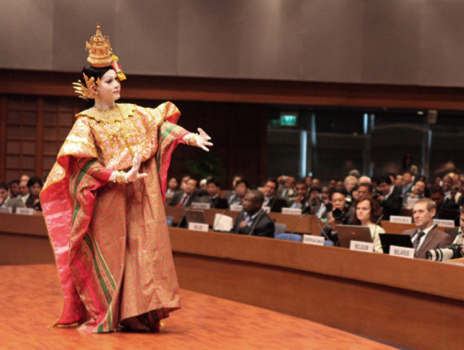During the meeting, participants considered two draft decisions on amendments to the Montreal Protocol to address Hydrofluorocarbons (HFCs), presented by the US, on behalf of Canada and Mexico, and the Federated States of Micronesia.
 12 November 2010: The 22nd session of the Meeting of the Parties (MOP 22) to the Montreal Protocol on Substances that Deplete the Ozone Layer, which took place in Bangkok, Thailand, from 8-12 November 2010, adopted 16 substantive and several procedural decisions, including on the terms of reference (ToR) for the evaluation of the financial mechanism.
12 November 2010: The 22nd session of the Meeting of the Parties (MOP 22) to the Montreal Protocol on Substances that Deplete the Ozone Layer, which took place in Bangkok, Thailand, from 8-12 November 2010, adopted 16 substantive and several procedural decisions, including on the terms of reference (ToR) for the evaluation of the financial mechanism.
The annex to the decision (UNEP/OzL.Pro.22/CRP.18) contains the ToRs for the evaluation, which specifies, inter alia, that the evaluator should analyze other environmental and health co-benefits, including climate, as well as adverse effects resulting from Multilateral Fund (MLF) activities to phase out ozone depleting substances (ODS).
During the meeting, participants considered two draft decisions on amendments to the Montreal Protocol to address Hydrofluorocarbons (HFCs), presented by the US, on behalf of Canada and Mexico (UNEP/OzL.Pro.22/5), and the FSM (UNEP/OzL.Pro.22/6). On behalf of Canada and Mexico, the US also introduced a draft decision on the phase-out of HFC-23 as a by-product of HCFC-22 (UNEP/OzL.Pro.22/3, XXII/[M]).
General support for the proposals was expressed by the Former Yugoslav Republic of Macedonia, the Philippines, Kenya, and Tuvalu, on behalf of Pacific island countries. Switzerland, Japan, Australia, Gabon, Armenia, Indonesia, Cameroon and the EU supported discussions on the proposals in a contact group, and Venezuela objected to the initiation of a contact group. Brazil, with China, called on parties to consider the proposals submitted in informal consultations only, as HFCs are already covered under the UNFCCC.
An informal group was established and met twice during the week to focus on the proposal by Brazil requesting the Technology and Economic Assessment Panel (TEAP) to assess the quantities and types of high-global warming potential (GWP) substances that are likely to be phased in as alternatives to HCFCs, as well as to identify the affected sectors and the extent to which the funding guidelines on Hydrochlorofluorocarbons (HCFCs) would allow for the selection and financing of low-GWP alternatives to HCFCs by Article 5 parties (UNEP/OzL.Pro.22/CRP.13). Aside from a brief US introduction of its amendment proposal, the informal contact group did not initiate specific discussion on this matter, as several parties objected to discussing this, and no decision was adopted by the MOP.
Although MOP 22 was not able to make progress on low-global warming potential alternatives, or ODS destruction, many delegates identified these issues as key to the long-term future of the Protocol. Although the draft decisions to amend the Montreal Protocol to include HFCs were not successful, their proponents remained committed to addressing HFCs through the Montreal Protocol in the future. [IISD RS Coverage] [Meeting Website]